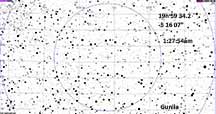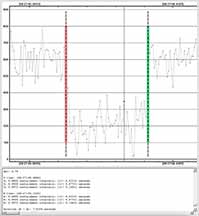


This is a good event: lasts a long 6.5s, high in the sky (45 degrees, azimuth=157), deep drop to 14.0 magnitude. It should permit short integration and high accuracy D and R sky plane points. And, there are 11 observers signed up, as it also passes through observer-rich southern Arizona. Kirk, Karl and I are all inside the path from our homes, and the centerline passes right through the center of Santa Cruz. It's difficult to get south of the centerline, because that would require a long drive to near Monterey to accomplish. The problem is that Paul Maley has placed himself on the centerline, on top of Kirk Bender. I've decided to move north some, to Upper Rodeo Gulch Rd to relieve a bit of the conjestion. Karl should be able to get this too, from farther north. I'm hoping that Paul Maley will chose to go south of the centerline to better space observers. The marine layer may still be in force and that would force Kirk to go up into Bonny Doon, perhaps the Eco Reserve would be good. That would still be south of my site at upper Rodeo Gulch. It doesn't look like the marine layer will be deep and pervasive, but instead just shallow and along the coast.
As usual, the charts below are for an 8SE Celestron telescope using a 32mm Q70 eyepiece, and a Watec 910hx camera with f/3.3 reducer.
 |
 |
 |
A big success for Team Santa Cruz. Kirk, Karl and I all got good solid positive occultations. The star was almost lost on the bright sky on my live LCD and I didn't see the D very well. It didn't register that it had disappeared until a few seconds later. My guess that it was gone for 3 or 4 seconds was wrong; it was gone for over 7 seconds on my high S/N taping. Kirk observed from the Eco Preserve at Bonny Doon. Karl observed from his front yard.
I drove to the top of Rodeo Gulch Rd and found a spot I could point properly from the back of my RAV4, and also that was in the shadow of some oak trees hiding the nearly full moon. I used Polaris and Nunki again as my align stars, and then a Go-To the target put the telescope dead-on the target star perfectly. There were no other cars driving by or parked nearby as sometimes happens. So, all went very well. I did have a little trouble getting a backup video on the LCD screen because I forgot to adjust the focus range on my PowerShot camera to macro-mode, and it failed to focus. As it turned out, it didn't matter. The camcorder worked fine. I used Sharpness=4, Gain=41 (max), Gamma=1.0, Integration=4x. Skies were clear, calm, warm, dry, and there was fog down below, extending up as far as Granite Creek Rd. It was good I didn't try it from Mill Rd or I'd have been fogged out.
magnitude drop measured at 1.29 vs. 1.6 predicted.
|
PyMovie screen capture of the settings, and the 5px circular static aperture on the target star (red box, lowest). I used dynamic apertures for the two tracking stars (in yellow). |
The target star light curve is in green. Nice clear drop during the 7s event. |
Reference star, chosen to be a star that was bright, but not bright enough to have any saturated pixels. |
Target star light curve in PyMovie |
Sky light curve |
|
Surprisingly huge red bar test. Good strong enough S/N ratio to pass the zero false positive e |
PyOTE square wave solution. |
Zoomed in. Tight confidence limits on the timings |
 |
 |
 |
 |
 |
Karl observed from his front yard at 1600 ft in the Santa Cruz Mtns. He set the Watec at 8x and got a very solid pair of timings, and a 6.6 second event. No clouds. I reset the time stamp setup for his Arduino VTI, and it found the time stamps properly, and there were no dropped fromes from his brand new tape download.
|
The target star is in the apertures at bottom, and near the middle of the frame |
The PyMovie composite light curves. Target in green; the occultation is clear |
PyMovie light curve |
Reference star light curve |
PyOTE reductions; using the 'square wave' static 4px aperture settings
|
The event passes the zero false positive test without doubt |
It took some time for Karl to settle on the positioning of the stars, so the settled period started not far before the event. However, I could follow it on the screen during the repositionings and no evident target loss such as a secondary event. |
Zoomed in. Very tight timing accuracies, but I'm curious about the 2-step bottom, suggesting a double star? |